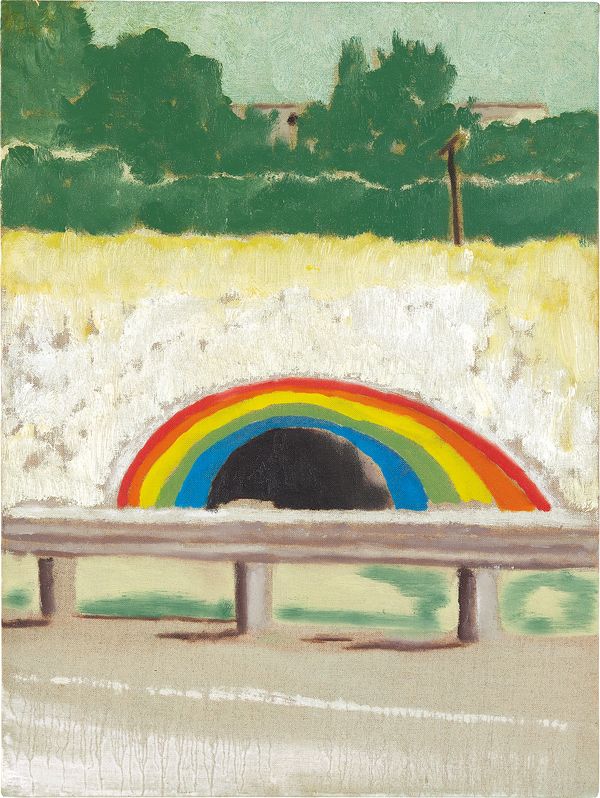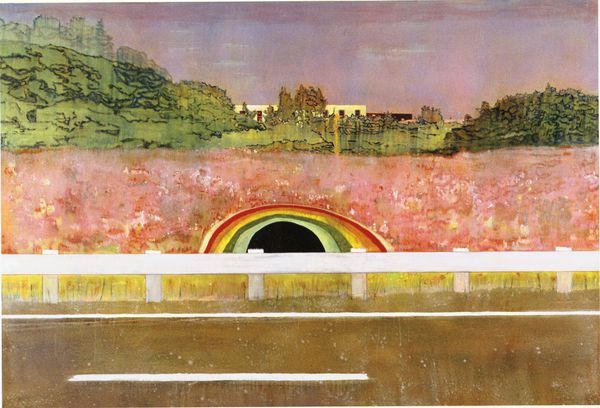Peter Doig Tunnel Painting (Country-rock), 2000
A reverie of pure nostalgia, Peter Doig's Tunnel Painting (Country-rock), 2000, is a dream-like soliloquy; a phantasmal scene of iridescent pigment against the ethereal layers rendered in grey and green. Characteristic of Doig's painterly output, this work recalls his years spent in Canada, manifested in a series of paintings based on the Don Valley Parkway, a tunnel built in 1961 on the eastern perimeter of the northbound highway in Toronto.
Now the main highway in and out of the city, the famous psychedelic rainbow tunnel, painted as a memorial by Berg Johnson at the tender age of 16, is now officially sanctioned as public art some 30 years on.
Between 1998 and 2000, Doig painted three monumental works centered on the Don Valley rainbow, one of which is presently in the collection of the Pinchuk Art Centre in Kiev while another was chosen as the lead illustration for the artist's seminal retrospective at the Tate Britain in 2008. Despite only featuring in three major canvases, Doig made a number of paintings, drawings, watercolours and aquatints that retell this unique experience, the mysterious view from the car seen by millions of commuters over several decades.
The deep blackness of the tunnel's center is enigmatic, at once suggestive of an entrance to another realm while also depicting an anonymous marginal urban space. As Doig has commented in Adrian Searle, Kitty Scott and Catherine Grenier's Peter Doig, London, 2007, "a lot of the works deal with peripheral or marginal sites, places where the urban world meets the natural world. Where the urban elements almost become, literally, abstract devices. There are a lot of 'voids' in the paintings. A lot of the paintings portray a sense of optimism that can often be read as being a little desperate, like the image of a rainbow painted around the entrance to an underpass."
I react to what happens during the making of a painting. This is what determines when a painting is finished for me. I have no ultimate plan, really. I want to be surprised. I would get very bored if I followed a procedure.
Peter Doig Country Rock, 1998–99. Ole Faarup Collection, Copenhagen © Peter Doig. All Rights Reserved/DACS 2017
The mastery of Doig's painterly technique carries the quality of memory. Layering thinned oil paint, the artist gradually works light, space and sentiment into his compositions. Commenting on his painterly technique, Doig noted to The Guardian in September 2009 that, for him, painting "is very much about the material…I react to what happens during the making of a painting. This is what determines when a painting is finished for me. I have no ultimate plan, really. I want to be surprised. I would get very bored if I followed a procedure."
Yearning, reminiscing and romanticising, Tunnel Painting (Country-rock) captures the mundane in a celestial and otherworldly light, disorientating the viewer with a metaphorical proposal of memory and fantasy. However, Doig has noted for Tate Britain, London in 2008, "People have confused my paintings with being just about my own memories. Of course we cannot escape these. But I am more interested in the idea of memory itself."
Doig began painting these geographically specific Canadian locations once he had settled in London in 1989. Identifying with Scotland, Canada, England and Trinidad, Doig's residency around the world has been eclectic and distinctly nomadic. Born in Edinburgh, Doig moved to Canada in 1960, residing for 19 years, predominantly in Montreal, Quebec's Eastern Townships and Toronto. Returning to Britain, he enrolled in three art schools, obtaining an M.A. in 1989-90 from the Chelsea School of Art, London. Just four years later, he received an acclaimed Turner Prize nomination. Trinidad has been the artist's primary residence since 2002, its terrain informing much of his painting. A heightened, almost melancholic, sense of dislocation from the Canadian landscape of his youth is thus tenable in his work from the 1990s and early 2000s.
I am more interested in the idea of memory itself.
A reference work by an earlier British artist: Peter Blake The Fine Art Bit, 1959 © Tate, London 2017/Peter Blake, All rights reserved, DACS, 2017
Capturing the majesty of the ordinary Canadian landscape, this work from our 20th Century & Contemporary Art Evening Sale offers a tangible sense of pictorial and cinematic drama. Passenger to the image, the viewer is transported into the artist's memory — a timeless dreamscape.
Emblematic of Doig's artistic endeavours both conceptually and visually, Tunnel Painting (Country-rock) is a paradigm of Doig's extensive corpus, affirming his rank as one of the most renowned living figurative painters.


